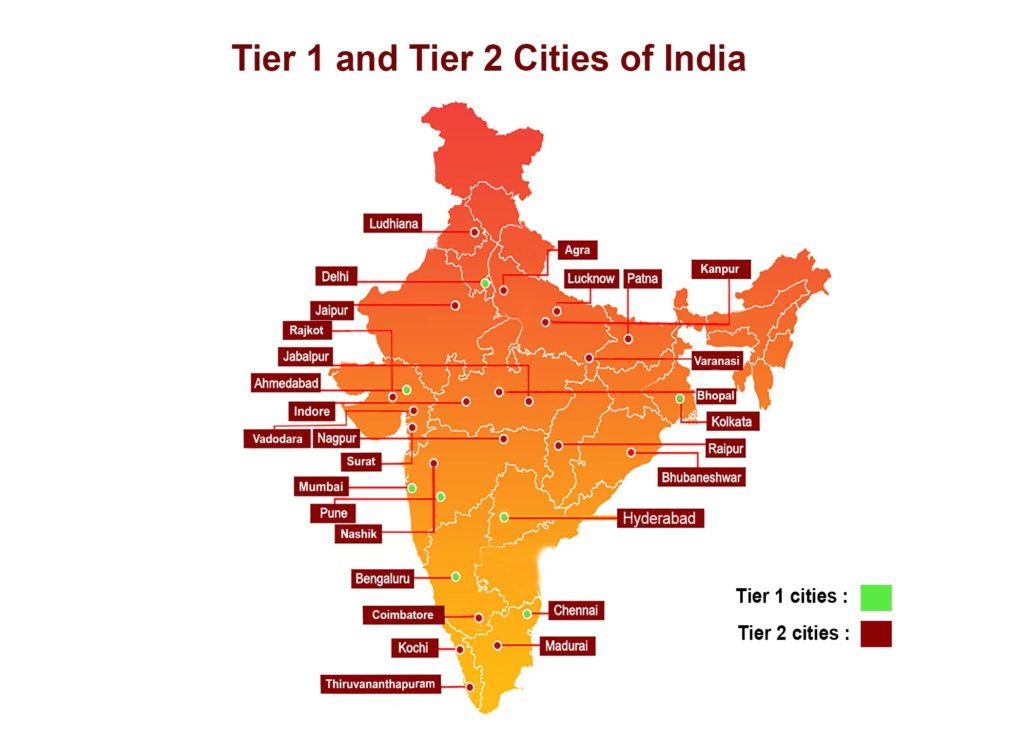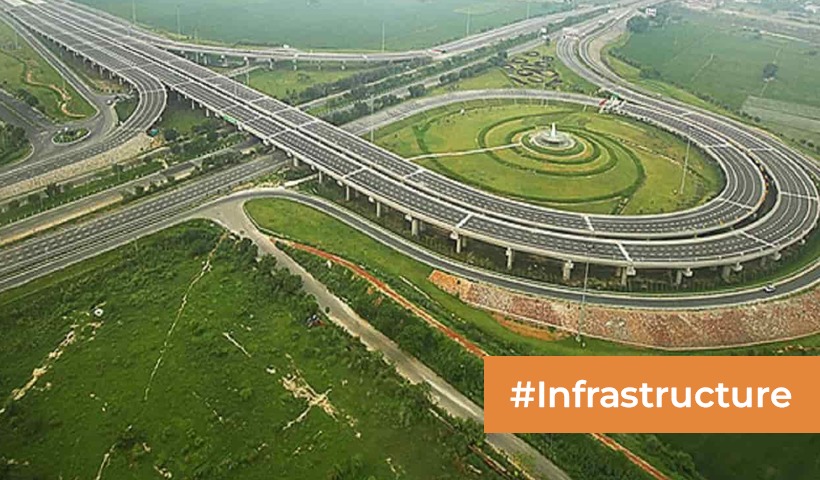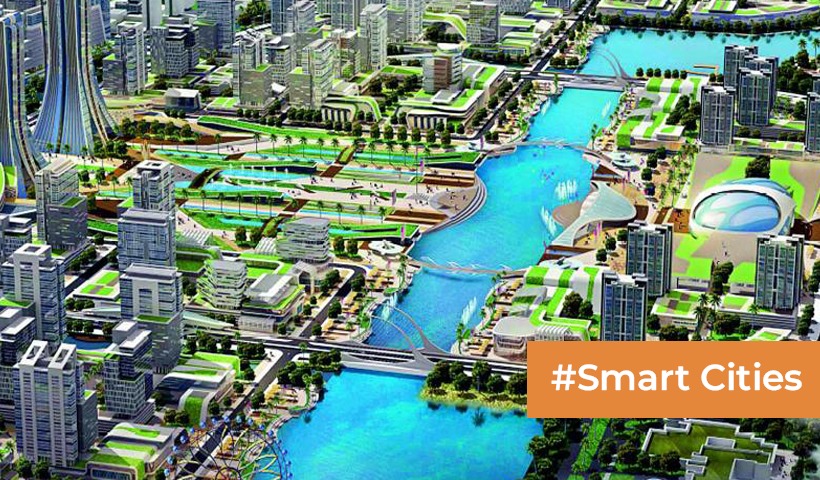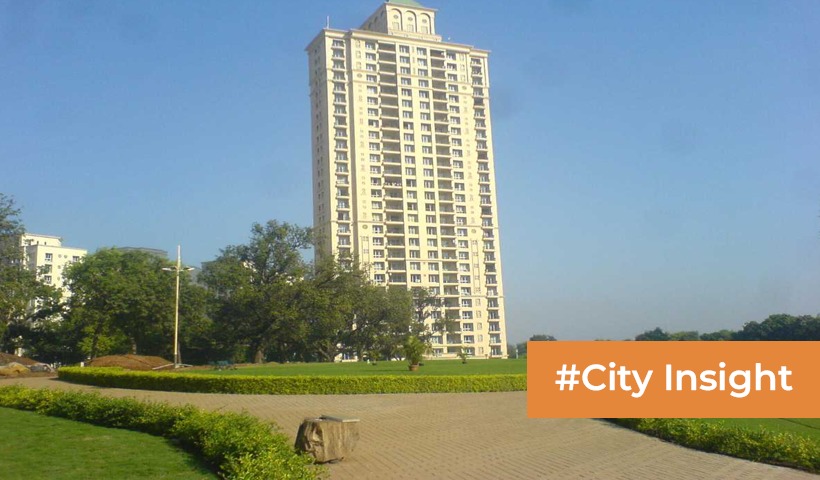What are Tier 1, 2, 3, and 4 cities in India? Understanding India’s urban tiers!
Tier I, II, III, and IV cities in India are a classification system used to categorize cities based on their population size, economic development, and infrastructure. The system was developed by the Reserve Bank of India (RBI) in 2001, and is still used today by government agencies, businesses, and real estate developers.
Understanding the classification of Indian cities into Tier I, II, III, and IV is crucial for grasping the country’s urban development landscape. This system, categorized by population, economic activity, and infrastructure, helps identify growth potential and investment opportunities across different urban centers.
What are the Tier Classification System of Cities in India
Tier I cities are the most developed and economically significant urban centers in India. They have a population of 1 lakh or more, and are typically home to major businesses, educational institutions, and cultural attractions. Some of the most well-known Tier I cities in India include Delhi, Mumbai, Bangalore, Chennai, Hyderabad, Kolkata, and Ahmedabad.
How many Tier 1 Cities in India
India’s Tier 1 cities are the major metropolitan hubs known for their significant population, economic activity, and advanced infrastructure. These cities are central to the country’s economic growth and development.
Here is a list of Tier 1 cities in India:
- Delhi
- Mumbai
- Chennai
- Kolkata
- Bangalore
- Hyderabad
- Ahmedabad
- Pune
Real Estate Investment Opportunities in Tier 1 Cities of India
Real estate investment in Tier 1 cities of India offers lucrative opportunities due to their robust infrastructure, economic dynamism, and high population density. Cities like Mumbai, Delhi, Bangalore, and Chennai attract investors with their thriving job markets, advanced transportation networks, and steady appreciation in property values. These cities also provide diverse investment options, from luxury apartments to commercial spaces, ensuring profitable returns and long-term growth potential for investors.
What are Tier 2 Cities in India?
Tier II cities are emerging urban centers that exhibit considerable growth potential and investment opportunities. They have a population of 50,000 to 99,999, and are typically home to smaller businesses, educational institutions, and cultural attractions. Some of the most well-known Tier II cities in India include Jaipur, Lucknow, Chandigarh, Pune, Surat, and Nagpur.
How many Tier 2 Cities in India
India’s Tier 2 cities are emerging hubs with significant growth potential, offering promising real estate investment opportunities. These cities are characterized by expanding infrastructure, increasing employment opportunities, and affordable property prices, making them attractive to investors.
Here are the top 20 Tier 2 cities in India:
- Jaipur
- Surat
- Nagpur
- Lucknow
- Indore
- Patna
- Bhopal
- Ludhiana
- Agra
- Vadodara
- Thiruvananthapuram
- Coimbatore
- Kochi
- Nashik
- Kanpur
- Madurai
- Varanasi
- Raipur
- Rajkot
- Jabalpur
Real Estate Investment Opportunities in Tier 2 Cities of India
Real estate investment in Tier 2 cities of India presents substantial opportunities due to lower property costs, growing infrastructure, and rising demand for residential and commercial spaces. Cities like Jaipur, Surat, and Lucknow are witnessing rapid development, making them attractive for investors seeking high returns. The expanding job markets and improved connectivity in these cities further enhance their appeal, providing a balanced blend of affordability and growth potential.

What are Tier 3 Cities in India?
Tier III cities are smaller urban areas that are gradually evolving and experiencing the impact of urbanization. They have a population of 20,000 to 49,999, and are typically home to small businesses, educational institutions, and cultural attractions. Some of the most well-known Tier III cities in India include Amritsar, Bhopal, Bhubaneswar, Visakhapatnam, Indore, and Guwahati.
How many Tier 3 Cities in India
India’s Tier 3 cities, though less developed than their Tier 1 and Tier 2 counterparts, are rapidly growing and present new opportunities for investment and development. These cities have seen significant population and economic growth, making them vital contributors to India’s overall economy.
Here are the top 20 Tier 3 cities in India:
- Etawah
- Roorkee
- Rajahmundry
- Bhatinda
- Hajipur
- Rohtak
- Hosur
- Gandhinagar
- Junagadh
- Udaipur
- Salem
- Jhansi
- Madurai
- Meerut
- Mathura
- Bikaner
- Cuttack
- Vijayawada
- Nashik
- Gwalior
Real Estate Investment Opportunities in Tier 3 Cities of India
Real estate investment in Tier 3 cities of India offers substantial potential due to their rapid economic growth and increasing urbanization. These cities, such as Rajahmundry, Rohtak, and Udaipur, present affordable property prices and rising demand for both residential and commercial spaces. Investors can benefit from the expanding infrastructure, improved connectivity, and growing local economies, which contribute to higher returns on investment over time.
What are Tier 4 Cities in India?
Tier IV cities are the smallest urban areas in India. They have a population of 10,000 to 19,999, and are typically home to small businesses, educational institutions, and cultural attractions. Some of the most well-known Tier IV cities in India include Madurai, Tirupati, Vadodara, Varanasi, and Kochi.
How many Tier 4 Cities in India
India’s Tier 4 cities are smaller towns with populations between 10,000 and 19,999, often located in more remote areas with limited infrastructure. These cities have significant growth potential and offer unique investment opportunities due to their untapped markets.
Here are the top 20 Tier 4 cities in India:
- Banswara
- Bhadreswar
- Chilakaluripet
- Datia
- Gangtok
- Kalyani
- Kapurthala
- Kasganj
- Nagda
- Sujangarh
- Chittorgarh
- Haridwar
- Sikar
- Dibrugarh
- Bhilwara
- Munger
- Deoghar
- Purnia
- Rewari
- Karauli
Real Estate Investment Opportunities in Tier 4 Cities of India
Real estate investment in Tier 4 cities of India offers unique opportunities due to their significant growth potential and untapped markets. These smaller towns, such as Gangtok, Kalyani, and Banswara, provide affordable property prices and the chance for early entry into developing areas. With strategic planning and investment, these cities can transform into vital economic hubs, offering high returns over time. Investors can benefit from the growing demand for residential and commercial spaces as these towns develop their infrastructure and connectivity.
What are the parameters of City Classification Into Tiers?
The classification of Indian cities into different tiers helps in understanding their development, economic potential, and infrastructure readiness. This system categorizes cities based on various parameters to provide a clear picture of their growth prospects and investment opportunities. Here are the key parameters used for city classification:
- Population: The total number of residents in the city, indicating its size and density.
- Economic Activity: The level of business, trade, and industrial activities, reflecting the city’s economic health.
- Infrastructure: Availability and quality of facilities like transportation, healthcare, and education.
- Employment Opportunities: The diversity and availability of jobs in various sectors.
- Income Levels: Average income of the residents, showing the economic status of the population.
- Urbanization: The extent of city development and spread of urban areas.
Government Policies: Support, initiatives, and incentives provided for urban development and growth.
Classification of Indian Cities in Tiers by Population
The classification of Indian cities into tiers by population helps in understanding their urban development and economic significance. This system is based on the population size of the cities, reflecting their growth potential and infrastructure needs.
Classification of Cities by Population:
- Tier 1 Cities: Population of more than 4 million.
- Tier 2 Cities: Population between 1 million and 4 million.
- Tier 3 Cities: Population between 100,000 and 1 million.
- Tier 4 Cities: Population less than 100,000.
What is the purpose of Classifying Indian Cities in Tiers
Classifying Indian cities into tiers serves several important purposes, aiding in urban planning and policy formulation. This system helps allocate resources, plan infrastructure, and drive economic development effectively.
Purpose of Classifying Indian Cities in Tiers:
- Resource Allocation: Efficient distribution of resources.
- Urban Planning: Strategic development planning.
- Economic Development: Boosting local economies.
- Policy Formulation: Tailored government policies.
- Investment Guidance: Informed real estate investments.
- Infrastructure Improvement: Targeted infrastructure upgrades.
Benefits of Tier Classification System of Cities in India
- Resource Allocation: Ensures resources are distributed according to the specific needs and capacities of each tier, optimizing efficiency.
- Urban Planning: Facilitates targeted urban planning and development strategies that cater to the unique requirements of each city tier.
- Economic Development: Encourages balanced economic growth by focusing on the strengths and opportunities of cities at different development stages.
- Policy Formulation: Enables the creation of tailored policies that address the distinct challenges and potentials of cities in various tiers.
- Investment Guidance: Provides investors with a clear understanding of market potential, helping them make informed decisions based on city classifications.
- Infrastructure Improvement: Prioritizes infrastructure projects based on city needs, promoting sustainable development and improved living standards.
This classification system is essential for fostering organized growth and maximizing the potential of urban areas across India.
The tier classification system is useful for a variety of purposes, including:
- Understanding the economic and social development of different cities
- Identifying cities with potential for growth and investment
- Planning and allocating resources to different cities
- Comparing the performance of different cities
FAQs
What are Tier-I and II cities?
Tier-I cities are major metropolitan hubs with large populations and advanced infrastructure. Tier-II cities are smaller but rapidly developing urban centers with significant economic and infrastructural growth.
What are Tier-III cities in India?
Tier-III cities are smaller urban areas experiencing population and economic growth. They have emerging markets and developing infrastructure, making them attractive for new business opportunities.
Which state has the most Tier 2 Cities in India?
Maharashtra has the most Tier 2 cities, including Nagpur, Nashik, and Aurangabad, which are significant centers for economic activities and development.
Are Tier 1 and Tier 2 Cities good for real estate investment?
Yes, Tier 1 and Tier 2 cities offer robust real estate investment opportunities due to their strong economic growth, advanced infrastructure, and high demand for residential and commercial properties.
What are the Tier 5 and Tier 6 Cities in India?
Tier 5 and Tier 6 cities are the smallest urban and rural areas with populations under 10,000. They have limited infrastructure and economic activities but potential for development.
The tier classification system is not without its critics. Some argue that the system is too simplistic and does not take into account other factors that contribute to the development of a city, such as its location, infrastructure, and culture. However, the system remains a useful tool for understanding and comparing different cities in India.
Disclaimer: The views expressed above are for informational purposes only based on industry reports and related news stories. PropertyPistol does not guarantee the accuracy, completeness, or reliability of the information and shall not be held responsible for any action taken based on the published information.




